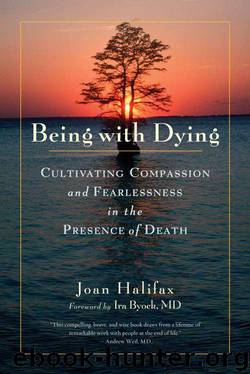Being With Dying: Cultivating Compassion and Fearlessness in the Presence of Death by Joan Halifax

Author:Joan Halifax [Halifax, Joan]
Language: eng
Format: epub
Tags: Sociology, Death, Religion & Spirituality, Buddhism
ISBN: 9780834821743
Publisher: Shambhala Publications
Published: 2009-11-17T06:00:00+00:00
1. Simone Weil, “The Love of God and Affliction,” in Waiting for God, trans. Emma Craufurd (New York: G. P. Putnam’s Sons, 1951), 64.
12
Wounded Healers
The Shadow Side of Caregiving
YOU PROBABLY are already familiar with the archetypes of caregiving, negative as well as positive. On the one hand there’s the selfless saint, possessing seemingly endless resources of compassion and generosity. On the other there’s the martyr—bitter, exhausted, and unable to perform the smallest service without simmering resentment. While caregiving can be one of the most noble and useful practices life has for us, one that is healing for both dying people and their supporters, a glowing, beatified image of service can cast a very long, very dark shadow. Strangely, the more glorified our idealization of the caregiver who’s never tired or irritable or needy, the more likely we are to invite that other archetype instead, as aspects of the shadow emerge and make their way forward.
Sandy’s caregivers, for example, found themselves falling prey to their fatigue toward the end of her illness. Every few months, the dying woman moved to the edge of death, then back toward life again. These rough tides began to take their toll on Sandy’s friends, who had been providing a home for her as well as taking care of her for years. Worn out and disheartened, her friends became suspicious that she was clinging to life, unable to surrender to the inevitable.
Finally—when Sandy became extremely demanding, angry, and chaotic—her friends had no more personal resources with which to help her. In attempting to care completely for Sandy, they had taken on more than they had bargained for. They had not created a plan for the long haul—and long is exactly what it was. At that point, they tried to find someplace else for her to stay.
Sandy fortunately did not have to move; a new group of friends stepped in to help, visiting every day, sitting with her for hours and sharing practice with her. She was particularly interested in the Tibetan practice of consciousness transference at the time of death. She also wanted to be held and read to. This new group of caregivers enabled her old friends to pull away from Sandy to a healthier distance and to relax somewhat. Yet they still felt ashamed, as if they had somehow failed her.
As time passed, Sandy’s pain became so extreme that she was given large amounts of medication so she could rest. People sat with her twenty-four hours a day as she moved closer to death. And then one day she was gone. Bearing witness to her death was challenging, but it was even harder to be with the pain of friends who had withdrawn after their energy had been used up. All the love and support that the rest of us offered could not allay their guilty belief that they should have done more. Yet perhaps what they really could have done was less.
This situation has continued to serve me as a hard-learned reminder of the power of the shadow.
Download
This site does not store any files on its server. We only index and link to content provided by other sites. Please contact the content providers to delete copyright contents if any and email us, we'll remove relevant links or contents immediately.
They Both Die at the End by Adam Silvera(9721)
Thirteen Reasons Why by Jay Asher(8796)
The Space Between by Michelle L. Teichman(6861)
Suicide Notes by Michael Thomas Ford(4764)
Tuesdays with Morrie by Mitch Albom(4693)
Suicide: A Study in Sociology by Emile Durkheim(2974)
The Checklist Manifesto by Atul Gawande(2779)
Tuesdays With Morrie by Mitch Albom(2697)
In the Woods by Tana French(2533)
Bossypants by Tina Fey(2466)
Robin by Dave Itzkoff(2383)
Olive Kitteridge by Elizabeth Strout(2308)
No Ashes in the Fire by Darnell L Moore(2297)
Reservoir 13 by Jon McGregor(2242)
End of Days by Sylvia Browne(2118)
All Things New by John Eldredge(2105)
Bus on Jaffa Road by Mike Kelly(2102)
Scar Tissue by Anthony Kiedis(2089)
No Time to Say Goodbye(2059)
